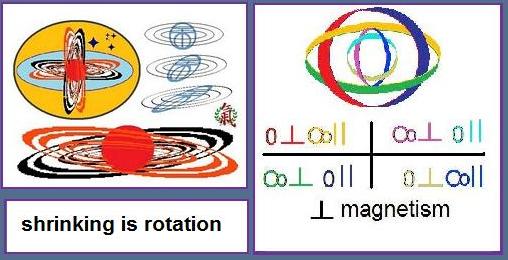
The Two Physics at the Dawn of Mathematical Models
L. Edgar Otto 30 March, 2012
In retrospect Feynman's popular book Three Easy Pieces (and Six Not so Easy Pieces) reads to me more like a philosophic stance rather dated yet influential in its time. I expected more even as a work for the general public. If physics is to be unified, the search for a mechanism, it will not be done by his foundations, philosophy, alone. Do we do the physics in the ways we do because it works while perhaps even in principle we do not know the how of it, the underlying mechanism? In particular what is gravity and mass and why in stable but great differences the measures mess on scales.
As abstraction in his sense the laws of nature are at a distance even from within concerning symmetries. Where I have used the term it presents a concrete idea of abstraction, the why beyond our seemingly chance fortune that mathematics does work for the physics.
We have a gods-eye view as we change from one philosophic and intuitive flavor of the day to the other and should not assume no layer is there as more foundational, in the new physics our world can be a little wider as should be the experience and encounter with the world as science.
He mentions, at the beginning, a publication by Galileo called the two physics- that of motion inspired by the motion of planets in the sky, and the discovery of the effects of scaling intrinsic to nature. At this beginning, what became Newtonian and then Einstein's ideas of relativity, we see the split also where we can take a godseye view of atoms as from the outside and thus a reduction to the spherical. We have the earlier and fundamental debate as to what is atoms and what a physics of a unified, perhaps Platonic view as Feynman observed the Greek idea of perfection such as for the circle, as well its symmetry. He ends one part with the cleaver reversal mentioning a perfect building with small statues with an error of one so we do not offend the God, says in in reverse that nature as made by the godlike laws perhaps has its errors so man would not be jealous of his perfection.
So, as usual with those who dare to think and contemplate a balance in things in the asymmetry and broken symmetry of things we have competing ideas akin to monotheism as a sort of theory of everything of the God or gods. From one view, a consumate experimentalist he was aside, this leads to intuitive theories which may or may not correspond to the trivial results of our remote viewing of possible structures inside the atoms. How influential was he in the idea of quarks as partons? These things now said obsolete but in the spirit of the seeking thus true in principle.
Now it is cleaver in his explanations that of the three geometries, Euclidean and non-Euclidean, he uses the examples without mentioning the technical terms- little bugs crawling on such surfaces- one in particular for the hyperbolic space the very idea in this discussion of intrinsic curvature as a disc with a direction of sensing heat, the Escher like drawings inside the hot plate.
These representations of manifolds, and he does touch on the next dimension all part of the world, stand or fall together and in some senses can meld into each other like shifting neutrinos. Now he himself wrote that Einstein's view was a needed modification of Newton and suggests that Einstein needs some unknown further modification. So why do we wonder, for what reason do we cry things like Einstein, it always Einstein the he was wrong?
The reduction to Feynman diagrams can and is applied to some degree universally, it foreshadows the observation of the different directions of the quasic plane- but it is an inadequate tool to reach the depths of a more general span of the ideas of physics. Its monotheism does not explain the flatness of the world anymore than the tilings of Islamic art can see directly and explain- even if in the conflict between these fundamentalist the charge of polytheism for the Christian mystics seems tenably justified.
It is on a crude scale observed that symmetry in faces will get the most response for contests of beauty- but sometimes the anomalies, the subtle asymmetric differences in the lover carry the unique attractions. In any case they have to be very pronounced to be noticeable above a certain threshold. But I do not by that the initial conditions loaded the dice and set the ball rolling for but one handed DNA in the life processes or its evolution any more than I see no reason at the structural level, as in some formulations or as Rowlands points out in nilpotent Dirac foundations, that it is not a question or clue that other levels, like particles, can speak for a world where the asymmetric state is the norm.
Are we to defend the string theories as a theory of mechanism of which we do not know the laws provided we understand some things about scale, things moreover to which we can intervene to access energy in ways that hardly make much difference to the ongoing processes in the sun, that this is a virtual abstract theory that seems to work but is hardly abstractly concrete for the scope of which it claims.
* * * * *


No comments:
Post a Comment